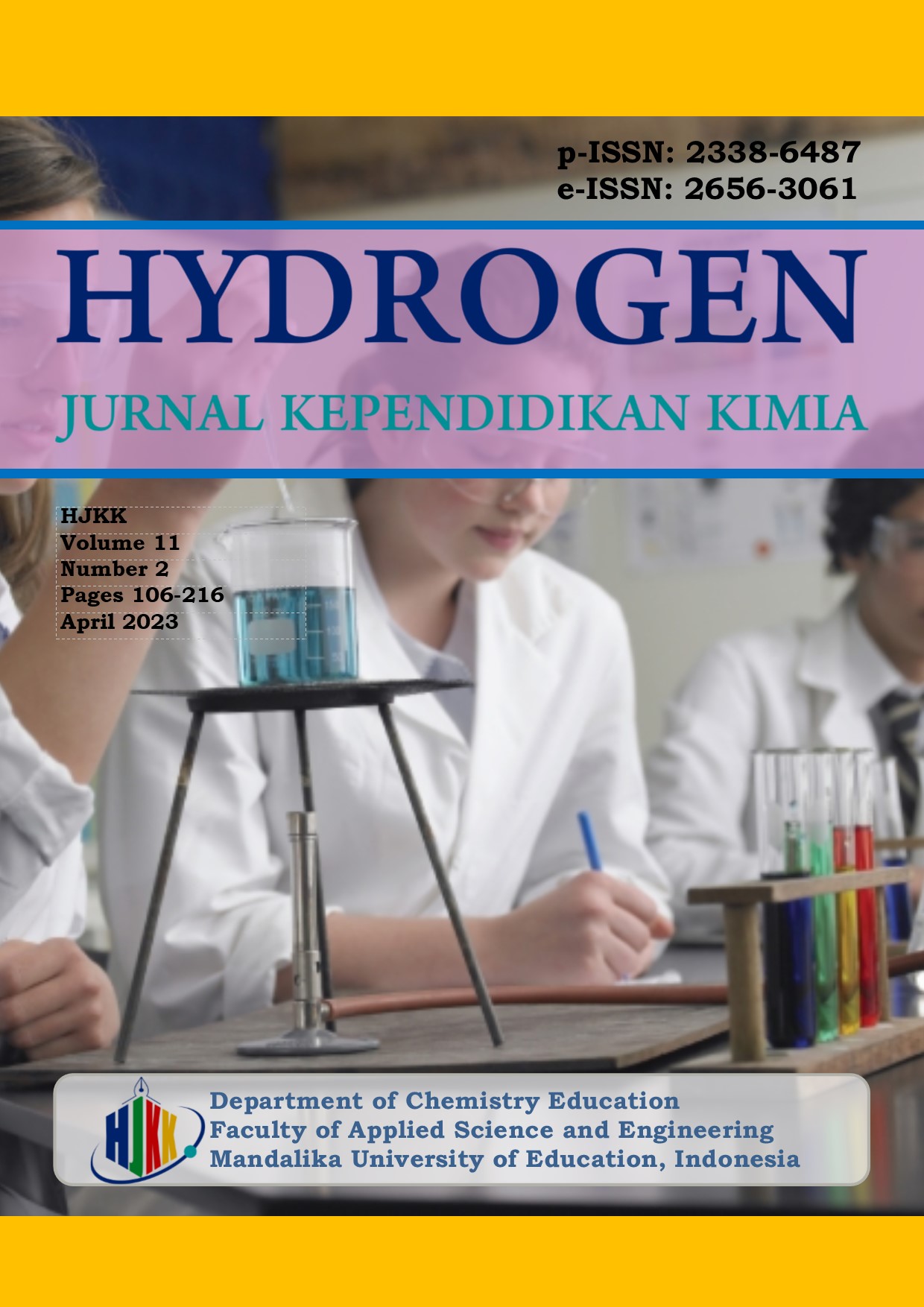The Effect of Using Zenius.Net-Based Learning Video Media on Student Chemistry Learning Outcomes at MA Anshor
DOI:
https://doi.org/10.33394/hjkk.v11i2.7258Keywords:
learning videos, zenius.net, learning outcomesAbstract
References
Agustina, A., & Novita, D. (2012). Pengembangan Media Pembelajaran Video Untuk Melatih Kemampuan Memecahkan Masalah Pada Materi Larutan Asam Basa. Unesa Journal of Chemical Education 1 , 10-16.
Arsyad, A. (2011). Media Pembelajaran. Jakarta: PT. Raja Grafindo Persada.
Budi, P. (2015). Pengembangan Media Video Pembelajaran Sifat kimia dengan Model Assure . Jurnal Kebijakan dan Pengembangan Pendidikan , 42-47.
Dwiya, Y. A. (2019). Hubungan Tingkat Perhatian Belajar Melalui Website “zenius. net†Dengan Tingkat Pemahaman Siswa (Studi Kuantitatif Di SMA 1 PSKD Jakarta. Jakarta: Doctoral dissertation, Universitas Bhayangkara Jakarta Raya.
Mardhiah, A., & Akbar, S. A. (2018). EFEKTIVITAS MEDIA PEMBELAJARAN TERHADAP HASIL BELAJAR KIMIA SISWA SMA NEGERI 16 BANDA ACEH. Lantanida Journal , 49-58.
Mardia, A., & Jafar, A. F. (2017). EFEKTIFITAS PENGGUNAAN MEDIA PEMBELAJARAN MONOPOLY GAME SMART TERHADAP MINAT BELAJAR PESERTA DIDIK. Jurnal Pendidikan Fisika , 19-25.
Riduwan, & Akdon. (2013). Rumus dan Data dalam Analisis Statistika (Z. Arifin, Ed.). Bandung: Alfabeta.
Safitri, B. R., Astutik, F., Fikri, A. N., & Saudiah, S. (2021). Pengaruh Video Pembelajaran melalui Zenius. Net terhadap Hasil Belajar Kognitif Biologi Siswa Madrasah Aliyah Kelas X dan XI. Bioscientist: Jurnal Ilmiah Biologi , 154-160.
Safitri, B. R., Pahriah, & Fuaddunnazmi, M. (2022). Efektivitas Video Pembelajaran Berbasis Zenius.Net Dalam MeningkatkanPemahaman Konsep Kimia Siswa. Hydrogen: Jurnal Kependidikan Kimia , 34-41.
Wikipedia. (2022, Maret 28). Zenius Education. Retrieved Agustus 1, 2022, from Zenius Education: https://id.wikipedia.org/wiki/Zenius_Education
Downloads
Additional Files
Published
How to Cite
Issue
Section
Citation Check
License
License and Publishing Agreement
In submitting the manuscript to the journal, the authors certify that:
- They are authorized by their co-authors to enter into these arrangements.
- The work described has not been formally published before, except in the form of an abstract or as part of a published lecture, review, thesis, or overlay journal.
- That it is not under consideration for publication elsewhere,
- That its publication has been approved by all the author(s) and by the responsible authorities – tacitly or explicitly – of the institutes where the work has been carried out.
- They secure the right to reproduce any material that has already been published or copyrighted elsewhere.
- They agree to the following license and publishing agreement.
Copyright
Authors who publish with Hydrogen: Jurnal Kependidikan Kimia agree to the following terms:
- Authors retain copyright and grant the journal right of first publication with the work simultaneously licensed under a Creative Commons Attribution License (CC BY-SA 4.0) that allows others to share the work with an acknowledgment of the work's authorship and initial publication in this journal.Â
- Authors are able to enter into separate, additional contractual arrangements for the non-exclusive distribution of the journal's published version of the work (e.g., post it to an institutional repository or publish it in a book), with an acknowledgment of its initial publication in this journal.
- Authors are permitted and encouraged to post their work online (e.g., in institutional repositories or on their website) prior to and during the submission process, as it can lead to productive exchanges, as well as earlier and greater citation of published work.
Licensing for Data Publication
Hydrogen: Jurnal Kependidikan Kimia uses a variety of waivers and licenses, that are specifically designed for and appropriate for the treatment of data: Open Data Commons Attribution License, http://www.opendatacommons.org/licenses/by/1.0/ (default) Other data publishing licenses may be allowed as exceptions (subject to approval by the editor on a case-by-case basis) and should be justified with a written statement from the author, which will be published with the article.







